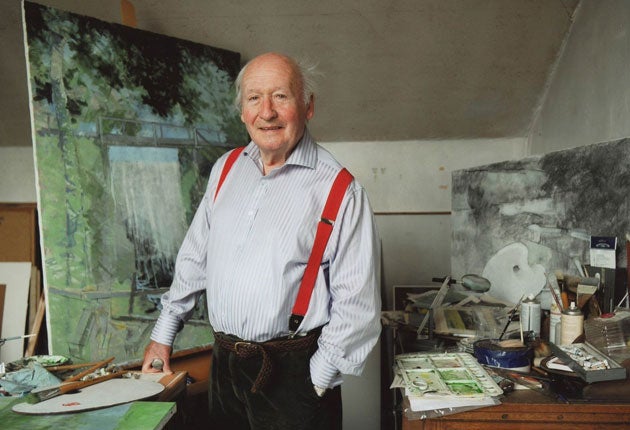TP Flanagan: Artist and teacher whose work inspired Seamus Heaney

"As an artist, he has gone his own way, explored the Irish landscape and enhanced Irish landscape painting through the discovery andelaboration of an individual style," Seamus Heaney wrote in 1995 in a tribute to his friend TP Flanagan. The occasion was a major retrospective of Flanagan's work at the Ulster Museum in Belfast, in which the full range and distinctiveness of the artist's accomplishments were acknowledged and applauded. Atmospheric, elegant and enchanting, the works on show were an endorsement of Flanagan's high standing among Irish artists of the 20th century.
Terence Philip (Terry) Flanagan was born in Enniskillen, Co Fermanaghin 1929, the eldest child in a family of seven. Following his mother's early death, the boy was brought up by a couple of aunts in the town, and educated by the Presentation Brothers at St Michael's School. At the same time, he attended classes in drawing and painting at Enniskillen Technical College, run by his earliest mentor, Kathleen Bridle, from whom he gained a valuable grounding in the techniques of watercolour painting.
Many of Flanagan's boyhood summers were spent with another aunt in the neighbouring county of Sligo, near the great house which Yeats commemorated in the poem beginning, "The light of evening, Lissadell..." Luminosity and a kind of vaporous delicacy became a feature of Flanagan's work, as the landscapes of Fermanagh and Sligo gained an increasing hold on his artist's imagination. During his middle period, for example, he produced some extremely evocative images of Castle Coole, near Enniskillen, in which architectural precision and clarity of line are tempered by a subtly romantic overlay.
In 1948, Flanagan enrolled as a student at the Belfast College of Art – then in an ebullient post-war phase of its existence – where his notable contemporaries included Basil Blackshaw and Kenneth Jamison. A sense of new beginnings was in the air, and gifted and idiosyncratic lecturers like Romeo Toogood, John Luke and Tom Carr helped to foster the students' talents.
After graduating from the Art College in 1953, Flanagan taught atvarious schools in the province before being appointed to a full-time lectureship in art at St Mary's Training College in Belfast, a post he held until his retirement in 1983. As a teacher, he placed a certain emphasis on traditional drawing skills. These were essential as the basis of an enduring art, he believed, even if an "experimental" approach should be adopted later. His "wonderfully liberating teaching" (Seamus Heaney's words) became a great source of artistic sustenance for many of his pupils.
As far as his own work was concerned, Flanagan resisted equally the tags "abstract" and "representational", as a creative individualist ducking out of the expectations imposed by either. He had no truck with restrictive definitions. Alongside his teaching, a parallel career as a professional artist in oils and watercolours was quietly flourishing throughout the 1960s and 1970s, with awards, exhibitions, honours, a television film (TP Flanagan: Painter) produced for the BBC by his friends David Hammond and Douglas Carson, and many works acquired for public and private collections, all testifying to his considerableexpertise in his chosen field. In 2010 he was awarded an honorary doctorate by the University of Ulster.
In 1959, Flanagan had married Sheelagh Garvin, an actress with the Lyric Theatre Company in Belfast, and the couple's three children were born over the next seven years. By the late 1960s, a strong friendship had been formed between the Flanagan and Heaney families, and the 1967 painting Boglands (for Seamus Heaney), partof the powerful "Gortahork" sequence, resulted in the complementary poem, "Bogland: for TP Flanagan", as a kind of inspiriting and affectionate interchange of ideas (and dedications) came into play.
It wasn't only with regard to his work that Flanagan made an impression.A friend has described him as "the most articulate man in the world", someone who was constantly demonstratinga way with words as subtle and accurate as his way with paint. Inventive (moorland he associated with marmalade, the islands of Lough Erne with a pear sliced in two), courteous and hospitable, he would keep his listeners enthralled for hours on end, whether at home in Belfast or at the cottage-with-studio-attached in South Donegal acquired by the Flanagans in the early 1970s as a respite from the escalating Troubles in the North, which only very occasionally get into the Flanagan oeuvre in an oblique and thought-provoking way.
Terence Flanagan not only enhanced Irish landscape painting, permanently affecting one's perception of the Irish countryside, but also, with his wife, Sheelagh, contributed an inestimable quality to the cultural life of the North of Ireland. His engagement with the effects of constantly changing light, light on water or the shimmer of sunlight after rain, makes him unique among recent Irish painters.
Terence Philip Flanagan, artist and teacher: born Enniskillen, Northern Ireland 15 August 1929; married 1959 Sheelagh Garvin (two sons, one daughter); died Belfast 22 February 2011.
Subscribe to Independent Premium to bookmark this article
Want to bookmark your favourite articles and stories to read or reference later? Start your Independent Premium subscription today.

Join our commenting forum
Join thought-provoking conversations, follow other Independent readers and see their replies